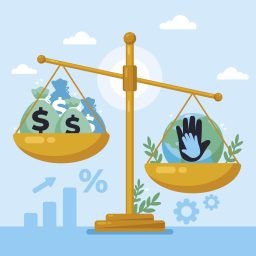
The fluctuation of interest rates can have a significant impact on both your savings and loan repayments. As someone who has navigated the ups and downs of the economy over the years, I’ve seen firsthand how changes in the interest rate environment can make a real difference in my personal finances.
When I was fresh out of college, I was eager to start building my savings and investing for the future. I opened a high-yield savings account, hoping to see my money grow steadily over time. However, just a few years later, the Federal Reserve started raising interest rates to combat rising inflation. While this was good news for borrowers like me who had student loans, it meant that the interest I was earning on my savings started to decline. I went from earning over 4% on my savings to barely 1% as the Fed aggressively hiked rates.
This shift was a wake-up call for me to reevaluate my savings strategy. I had to be more proactive in seeking out accounts that could keep pace with the rising rate environment, whether that was exploring online banks, money market funds, or even short-term bond funds. It was a constant balancing act, trying to maximize my returns without taking on too much risk.
On the flip side, when I was ready to take out a mortgage to buy my first home a few years later, the interest rate landscape had changed again. Rates had come down significantly, making it a much more favorable time to borrow. I was able to lock in a rate in the high 3% range, which saved me thousands of dollars over the life of the loan compared to what I would have paid just a couple of years prior.
The ebb and flow of interest rates is an ever-present factor that consumers have to navigate, whether you’re trying to grow your savings or finance a major purchase. In this blog post, we’ll dive deeper into how interest rates can impact both your savings and loans, so you can be better prepared to make informed financial decisions.
Understanding Interest Rates
At the most basic level, an interest rate is the cost of borrowing money or the return on saving money. It’s expressed as a percentage of the total amount borrowed or saved.
Interest rates are influenced by a variety of economic factors, including:
- Monetary policy set by the Federal Reserve: The Federal Reserve, the central banking system of the United States, plays a key role in setting interest rates. Through its monetary policy tools, the Fed can raise or lower short-term interest rates to achieve its dual mandate of promoting maximum employment and stable prices.
- Inflation: When inflation is high, the Fed will typically raise interest rates to make borrowing more expensive and saving more rewarding, with the goal of cooling down an overheated economy.
- Economic growth: Strong economic growth can lead to increased demand for loans, which in turn puts upward pressure on interest rates.
- Global economic conditions: Interest rates in the U.S. can also be influenced by interest rate movements in other countries, as well as global factors like trade, geopolitics, and commodity prices.
It’s important to note that there are different types of interest rates that can impact your finances in different ways. Some key interest rates to be aware of include:
- Federal funds rate: This is the interest rate at which banks lend money to each other overnight. It’s the benchmark that the Fed uses to influence other short-term interest rates.
- Prime rate: This is the interest rate that commercial banks charge their most creditworthy customers. It’s typically a few percentage points above the federal funds rate.
- Mortgage rates: These are the interest rates charged on home loans, which can be fixed or adjustable.
- Student loan rates: The interest rates on federal and private student loans can vary significantly based on the type of loan and when it was issued.
- Credit card rates: Credit card companies set their own interest rates, which can be quite high compared to other types of loans.
Understanding these different interest rate benchmarks and how they relate to one another is crucial for making informed financial decisions.
How Interest Rates Affect Savings
When interest rates rise, it generally means better news for savers. Higher interest rates translate to higher yields on savings accounts, certificates of deposit (CDs), money market accounts, and other interest-bearing savings vehicles.
For example, let’s say you have $10,000 saved in a high-yield savings account. If the interest rate on that account is 0.50%, you would earn $50 in interest over the course of a year. However, if interest rates rise and the account now pays 1.50%, your annual interest earnings would jump to $150 – a 200% increase!
Of course, the reverse is also true. When interest rates fall, the interest earned on your savings will decline. This can be frustrating for savers who are trying to grow their nest egg, as their money won’t work as hard for them.
To combat this, many savers will look to diversify their savings across different account types and maturity lengths. This can include:
- High-yield savings accounts: These typically offer higher interest rates than traditional brick-and-mortar bank accounts, though the rates can still fluctuate with changes in the overall interest rate environment.
- Certificates of deposit (CDs): CDs lock in a fixed interest rate for a set period of time, ranging from a few months to several years. This can provide more stability, but you may have to pay a penalty if you need to withdraw the funds early.
- Money market accounts: These accounts combine features of both savings accounts and CDs, typically offering slightly higher yields than savings accounts while still providing relatively easy access to your money.
- Short-term bond funds: For those willing to take on a bit more risk, short-term bond funds can be a way to earn higher returns than a savings account when interest rates rise.
The key is to stay flexible and monitor interest rate trends so you can adjust your savings strategy accordingly. By diversifying your savings and being proactive about seeking out the best yields, you can help ensure that your money is working as hard as possible for you.
How Interest Rates Affect Loans
Just as higher interest rates can benefit savers, they can be a burden for borrowers. When the Fed raises interest rates, it becomes more expensive for consumers and businesses to take out loans.
This is particularly noticeable in the mortgage market. As interest rates rise, the monthly payments on new home loans increase, making it more challenging for prospective homebuyers to afford a house. For example, on a $300,000 mortgage, a 1% increase in the interest rate can translate to several hundred dollars more per month in mortgage payments.
The impact of rising interest rates is also felt in other types of loans, such as:
- Auto loans: Higher rates mean higher monthly payments for those financing a new or used vehicle purchase.
- Student loans: While federal student loan interest rates are fixed, private student loan rates can fluctuate with changes in the overall interest rate environment.
- Business loans: Companies that need to borrow money to finance operations, expansions, or other investments will face higher borrowing costs as interest rates rise.
- Personal loans: Unsecured personal loans, often used for debt consolidation or major purchases, also become more expensive as interest rates go up.
On the flip side, when interest rates fall, it can be an opportune time for borrowers to refinance existing loans or take out new ones. Refinancing a mortgage, for example, can potentially save you thousands of dollars over the life of the loan by lowering your monthly payments.
However, it’s important to carefully consider the pros and cons of refinancing, as there may be upfront costs and fees involved. Additionally, the length of time you plan to stay in your home should factor into the decision, as the breakeven point for recouping the refinancing costs may take several years.
To help illustrate the impact of interest rate changes on loans, let’s look at a couple of comparison tables:
Mortgage Payment Comparison
| Loan Amount | Interest Rate | Monthly Payment |
|---|---|---|
| $300,000 | 4.0% | $1,432 |
| $300,000 | 5.0% | $1,610 |
| $300,000 | 6.0% | $1,799 |
Auto Loan Payment Comparison
| Loan Amount | Interest Rate | Loan Term | Monthly Payment |
|---|---|---|---|
| $25,000 | 4.0% | 60 months | $452 |
| $25,000 | 6.0% | 60 months | $479 |
| $25,000 | 8.0% | 60 months | $507 |
As you can see, even small changes in interest rates can have a significant impact on the monthly payments for major loans like mortgages and auto loans. Borrowers need to be mindful of these dynamics and factor them into their financial planning.
Ready to take control of your finances? Visit upgrade.com now to explore a range of financial products, including Personal Loans, Auto Refinance Loans, Home Improvement Loans, Personal Credit Lines, and Upgrade Card. Let Upgrade help you achieve your financial goals today!
Strategies for Navigating Interest Rate Changes
Given the significant role that interest rates play in both savings and loans, it’s crucial for consumers to have a proactive strategy for managing their finances in the face of changing rate environments. Here are some tips:
- Monitor interest rate trends: Stay informed about what’s happening with interest rates, both at the Federal Reserve level and in the broader market. This will help you anticipate potential changes and make adjustments to your savings and borrowing strategies accordingly.
- Diversify your savings: Don’t keep all your money in a single savings account or CD. Spread your savings across a mix of high-yield accounts, short-term bonds, and other interest-bearing instruments to hedge against rate fluctuations.
- Time your borrowing strategically: If you know you’ll need to take out a major loan in the near future, such as a mortgage or auto loan, try to time it when interest rates are lower. Conversely, if you have an existing loan, consider refinancing when rates drop.
- Explore adjustable-rate options: For loans like mortgages and student loans, you may have the option to choose between a fixed-rate or adjustable-rate product. Adjustable-rate loans can be beneficial when rates are rising, as your payments will adjust accordingly.
- Maintain financial flexibility: Avoid locking yourself into long-term, fixed-rate savings or loan products if you think rates may change significantly in the near future. Keep some of your savings liquid and be prepared to refinance loans if the opportunity arises.
- Consult with financial professionals: If you’re unsure about how to best position your finances in the current interest rate environment, don’t hesitate to seek guidance from a qualified financial advisor or lender. They can provide personalized advice and strategies tailored to your specific situation.
By staying informed, diversifying your financial portfolio, and maintaining flexibility, you can navigate the ups and downs of interest rates and ensure that your savings and loans are working as hard as possible for you.
Conclusion
Interest rates are a critical factor that can have a significant impact on both your savings and your loans. When rates rise, savers benefit from higher yields on their deposits, but borrowers face higher monthly payments on mortgages, auto loans, and other financing.
Conversely, when rates fall, the opposite is true – savers earn less on their money, but borrowers can potentially save thousands by refinancing existing loans or taking out new ones at more favorable terms.
The key is to stay proactive and adaptable in your approach to managing your finances. Monitor interest rate trends, diversify your savings, time your borrowing strategically, and be willing to make adjustments as the economic landscape evolves.
By doing so, you can optimize your savings, minimize your borrowing costs, and put yourself in the best position to achieve your financial goals – whether that’s growing your nest egg, buying a home, or financing a major purchase. Interest rates may be outside of your control, but with the right strategies in place, you can learn to thrive in any interest rate environment.
Frequently Asked Questions (FAQs)
Q: How do interest rates affect my everyday savings accounts?
A: Interest rates directly impact the amount of interest you earn on your savings accounts. When rates rise, you earn more interest on your savings, helping your money grow faster. Conversely, when rates fall, the interest you earn decreases, which can affect your overall savings growth.
Q: Can I negotiate the interest rate on my existing loans?
A: In most cases, the interest rate on existing loans is fixed and cannot be renegotiated. However, you may have the option to refinance your loan at a lower rate if market conditions are favorable. Refinancing involves taking out a new loan to pay off the existing one, potentially saving you money in the long run.
Q: How often do interest rates change, and who decides these changes?
A: Interest rates can change frequently, depending on economic conditions and monetary policy decisions. The Federal Reserve is responsible for setting the federal funds rate, which influences other interest rates in the economy. The Fed meets regularly to assess economic indicators and adjust rates as needed to achieve its objectives.
Q: Are there any benefits to rising interest rates for borrowers?
A: Rising interest rates generally mean higher borrowing costs for consumers. However, one potential benefit for borrowers is that rising rates can lead to higher yields on savings accounts, making it more rewarding to save money. Additionally, some adjustable-rate loans may offer lower initial rates compared to fixed-rate loans in a rising rate environment.
Q: How can I protect my savings from fluctuating interest rates?
A: To protect your savings from fluctuating interest rates, consider diversifying your savings across different types of accounts with varying maturities and interest rates. High-yield savings accounts, CDs, money market accounts, and short-term bond funds are all options to explore. By spreading your savings across different vehicles, you can mitigate the impact of rate changes on your overall savings growth.
Share Your Expertise, Build Your Business. Tired of limitations?
Create & sell online courses with Teachable. Keep 100% control. Start your free!


















